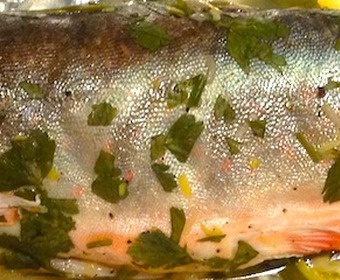
Baking fish like a pro
- Vary your techniques
- Don’t over-complicate things when you’re baking whole fish
- Think about color and flavor when cooking au gratin
Baking fish in the oven can actually involve quite a lot of different cooking techniques: Poaching, steaming, au gratin or baking the fish in its own skin.
Just pop it into the oven
Whole fish and cutlets are ideal for oven cooking. Stuff a whole turbot or pike-perch with fresh herbs and plenty of salt and wrap it in foil. The fish should have its head still on but remove the gills and any blood.
Set the oven to 90°C and place the parcel on a baking sheet. Use a thermometer and remove the fish when the inside temperature is about 50°C. The cooking time depends how big the fish is. If the flesh falls apart easily when you put a fork into the thickest part of the fish, it’s done. Serve with melted butter and horseradish, for example.
A beautiful oven-baked fish on the table looks appealing, smells inviting and tastes fantastic. Don’t over-complicate things. Put your time, energy and ingenuity into the accompaniments.
Baked flatfish
When you think a flatfish is done, feel along the backbone with your finger. When the flesh begins to come away when you touch it, the fish is done.
“Halibut is so amazingly handy. You can do anything you like with it.”
– Peppe Elmqvist, fourth generation fishmonger
Au gratin for flavor
Cooking fish au gratin is about cooking it among tasty ingredients and accompaniments so that the whole thing is enclosed and gains a beautiful, caramelized surface and a multitude of flavors. Some tips:
• Add egg yolk for a great color.
• Use a strongly flavored cheese, such as Gruyere. Go for variation.
• It’s a good idea to get everything ready in advance. The topping is often just a final step that adds color and flavor.
• If the butter is cold enough, you can shave it over the top.
• The temperature should be high.
“Cooking au gratin is all about color”
Chef Stefan Eckert, Lisa Elmqvist


